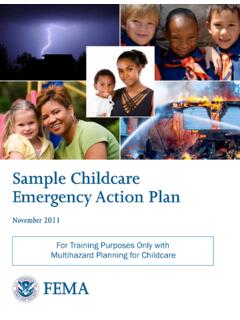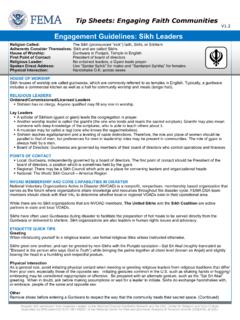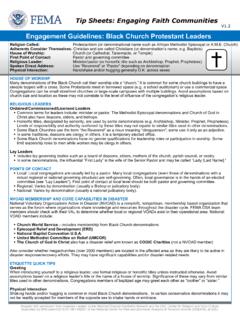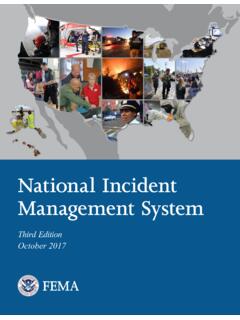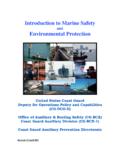Transcription of Dams Sector Security Awareness Guide
1 dams Sector Security Awareness GuideA Guide for Owners and Operators2007 List incident reporting or response agency contact information for your community and geographic region. Build relationships with these groups before an incident NumberCity Law EnforcementCounty Law EnforcementState Law EnforcementLocal Fire Service Local Joint Terrorism Task Force (JTTF)Local Federal Bureau of Investigation (FBI)FBI Weapons of Mass Destruction (WMD) CoordinatorFBI HotlineState Dam safety OfficeDownstream Dam OperatorUpstream Dam OperatorCity Emergency ManagementCounty Emergency ManagementState Emergency Coast GuardDepartment of Homeland Security (DHS) Protective Security Adviser for This StateState Fusion CenterAcknowledgments 1 AcknowledgmentsThe dams Sector Coordinating Council, dams Sector Government Coordinating Council, the Department of Homeland Security (the dams Sector -Specific Agency), and the Critical Infrastructure Partnership Advisory Council acknowledge the active support and participation from the following Security part-ners from the private Sector .
2 Allegheny Energy, Ameren Services Company, American Electric Power, Association of State Dam safety Officials, AVISTA Utilities, CMS Energy, Dominion Resources, Duke Energy, Exelon Corporation, National Hydropower Association, National Mining Association (ex officio), National Water Resources Association, New York City Department of Environmental Protection, New York Power Authority, Ontario Power Generation, Pacific Gas and Electric Company, PPL Corporation, Public Utility District 1 of Chelan County, WA, Scana Corporation, South Carolina Public Service (Santee-Cooper), Southern California Edison, Southern Company Generation, TransCanada, Society on dams , and Xcel Energy, and the following government Security partners.
3 Bureau of Reclamation (which also serves as representative for the Bureau of Indian Affairs, National Park Service, Bureau of Land Management, and other Department of Interior bureaus owning dams ), Federal Energy Regulatory Commission, International Boundary Water Commission, Mine safety and Health Administration, Natural Resources Conservation Service, Tennessee Valley Authority, Army Corps of Engineers, and State dam safety officials from California, Colorado, Nebraska, New Jersey, Ohio, Pennsylvania, Virginia, and Washington. DistributionThis 2007 dams Sector Security Awareness Guide was prepared under the auspices of the Department of Homeland Security . For distribution information, contact NoticeThis material does not constitute a regulatory requirement nor is it intended to conflict, replace, or super-sede existing regulatory requirements or create any enforcement 3 IntroductionLike all critical infrastructure, the technological and national Security environment in which the dam infrastructure is operated and maintained continues to evolve over time.
4 New threats to the continued reliability and integrity of all infrastructures require vigilance. Areas of possible focus by owners and operators include: surveillance detection, identification of site-related vulnerabilities ( , access control, operational Security , and cyber Security measures), emergency response/prevention issues, and functional-ity issues governed by interdependencies with other infrastructure dams Sector comprises the assets, systems, networks, and functions related to dam projects, naviga-tion locks, levees, hurricane barriers, mine tailings impoundments, or other similar water retention and/or control facilities. Dam projects are complex facilities that typically include water impoundment or con-trol structures, reservoirs, spillways, outlet works, powerhouses, and canals or aqueducts.
5 In some cases, navigation locks are also part of the dam address Security issues related to dams , a partnership approach has been adopted involving Federal, State, regional, Territorial, local, or tribal government entities; private Sector owners and operators and representative organizations; academic and professional entities; and certain not-for-profit and private volunteer organizations that share in the responsibility for protecting the Nation s critical Sector assets. 4 Benefits of dams to the NationBenefits of dams to the NationThe more than 82,000 dams throughout the United States and on the Nation s borders provide the country with a wide range of important economic, environmental, and social benefits.
6 These benefits include: Recreation Boating, skiing, camping, picnic areas, and boat launch facilities are all supported by dams . Flood Control dams impound floodwaters and then either release them under control to the river below the dam or store or divert the water for other uses. Water Storage Reservoirs created by dams supply water for industrial, municipal, and agricultural uses. Irrigation Ten percent of American cropland is irrigated using water stored behind dams ; thousands of jobs are tied to producing crops grown with irrigated water. Mine Tailings More than 1,300 mine tailing impound-ments allow the mining and processing of coal and other vital minerals while protecting the environment.
7 Electrical Generation dams produce more than 103,800 megawatts of clean, renewable electricity and meet up to 8 percent of the Nation s power needs. Debris Control Some dams provide enhanced envi-ronmental protection through the retention of hazardous materials and detrimental sedimentation. Navigation dams and locks provide for a stable system of inland river transportation throughout the heartland of the 1-1: Distribution of dams by Primary Purpose (Source: National Inventory of dams , 2005)Flood Control & Farm Ponds & Other Control as Critical Infrastructure and Key Resources of the Nation 5 dams as Critical Infrastructure and Key Resources of the Nation Because of the benefits they provide, dams are considered among the Nation s critical infrastructure and key resources (CIKR).
8 Critical infrastructures are those assets, systems, networks, and functions that are so vital to the United States that their incapacity or destruction would have a debilitat-ing impact on Security , national economic Security , or public health or safety . Key resources are the publicly or privately controlled resources that are essential to the minimal opera-tions of the economy and government. The Homeland Security Act of 2002 provides the basis for the responsibilities of the Department of Homeland Security (DHS) to protect the Nation s CIKR. More specifically, DHS is the Sector -Specific Agency (SSA) with responsibilities for the dams dams Sector comprises the assets, systems, networks, and functions related to dam projects, levees, navigation locks, hurricane barriers, mine tailing impoundments, and other similar water retention or water control facilities.
9 The dams Sector Security partners are the Federal, State, regional, territorial, local, or tribal government entities that own, operate, or regulate dams ; private Sector owners and operators of dams ; and organizations that share in the responsibility for protecting vast majority of the dams in the United States are pri-vately owned and operated. The dams Sector Coordinating Council (SCC) is the primary interface with DHS for private owners and operators on Security issues related to the dams Sector . The membership of the SCC and information on how to contact the SCC are provided in appendix dams Sector Government Coordinating Council (GCC) is the primary interface with DHS for dams that are not pri-vately owned.
10 The GCC membership and contact information are available in appendix B. The SCC and GCC partner with each other and the SSA to promote and facilitate Sector and cross- Sector planning, coordination, collaboration, and information sharing for the protection of assets within the dams Sector . This Guide is an example of that dams Sector Security Education Workgroup, comprising representatives of the SCC, GCC, and SSA, initiated develop-ment of the Guide . The workgroup recognized that dams could be perceived as potential targets by individuals wishing to inflict harm on the Nation and that it is therefore simply prudent to maintain a Security Awareness goals of this Guide are to enhance dam owners and operators Security postures by providing information on:1.



